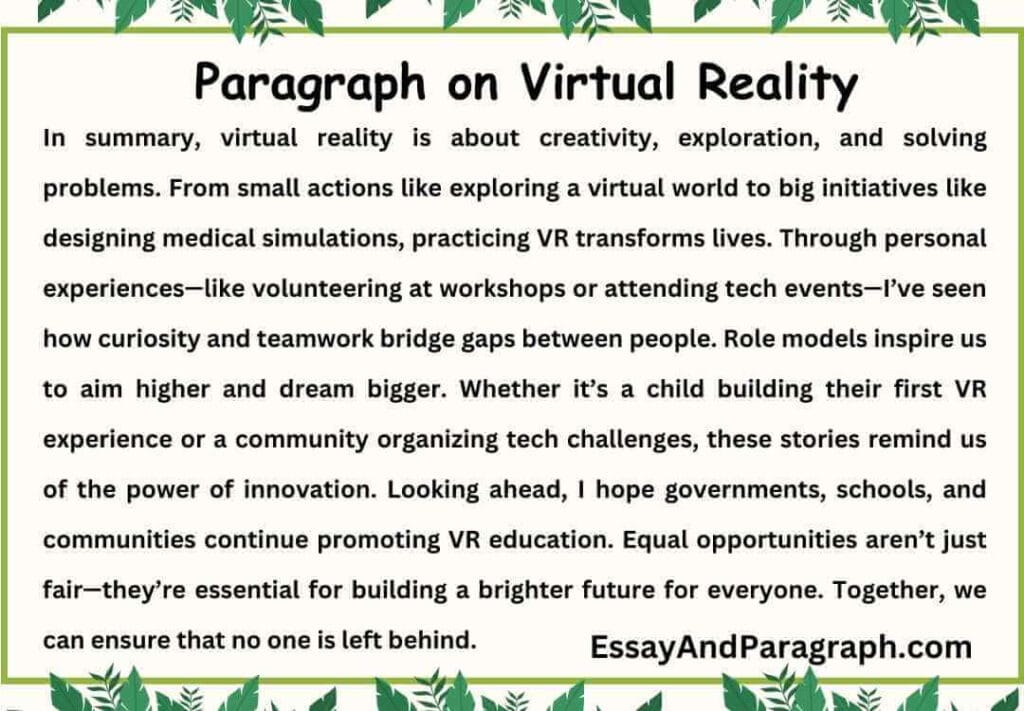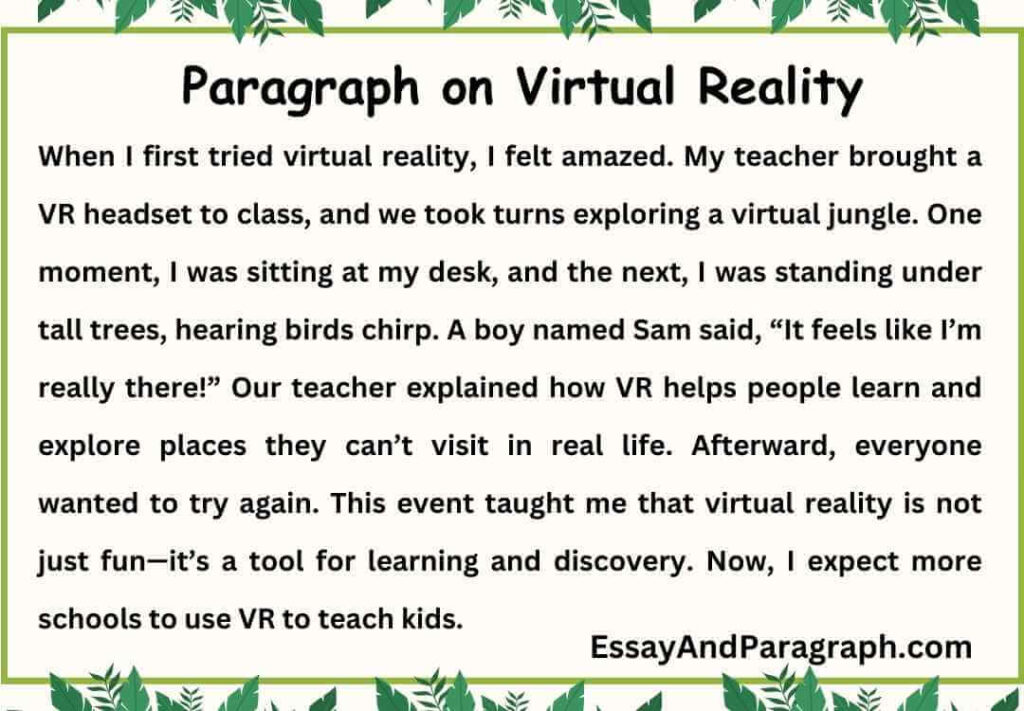Have you ever wondered what it would feel like to step into a completely different world without leaving your room? Virtual reality (VR) makes that possible! As someone who has explored and written about technology for years, I’m excited to share simple yet fascinating ideas with you. In this article, we will learn how to write paragraphs on virtual reality in different lengths (100, 150, 200, 250, and 300 words). By the end, you’ll understand why virtual reality matters and how it’s shaping the future. Let’s dive into this exciting topic together!
Paragraph on Virtual Reality – 100 words
When I first tried virtual reality, I felt amazed. My teacher brought a VR headset to class, and we took turns exploring a virtual jungle. One moment, I was sitting at my desk, and the next, I was standing under tall trees, hearing birds chirp. A boy named Sam said, “It feels like I’m really there!” Our teacher explained how VR helps people learn and explore places they can’t visit in real life. Afterward, everyone wanted to try again. This event taught me that virtual reality is not just fun—it’s a tool for learning and discovery. Now, I expect more schools to use VR to teach kids.

Paragraph on Virtual Reality – 150 words
The idea of virtual reality made me curious and excited. Last summer, my school held a VR workshop where students learned how VR works. At first, some kids were nervous because they had never used headsets before. But soon, everyone was laughing as they explored virtual worlds. Volunteers like my friend Mia helped explain how VR creates realistic experiences using special cameras and software. These interactions showed me how creative and immersive VR can be. After the workshop, many students felt inspired to learn more about technology. Some even started dreaming of becoming VR designers. The outcome was inspiring—people realized they could create amazing things. Looking ahead, I hope more communities offer programs like this. Virtual reality isn’t just about games; it’s about solving problems and exploring new ideas.
Paragraph on Virtual Reality – 200 words
Learning about virtual reality filled me with determination. Recently, my class visited a science museum where kids from different schools gathered to experience VR. We put on headsets and explored a virtual space station, floating around like astronauts. One girl, Lily, said, “I want to build a VR world like this someday!” Our teacher explained how engineers design VR experiences to help doctors practice surgeries or train pilots. Back at school, we organized a “VR challenge” where students created simple virtual worlds using apps. Seeing classmates cheer after completing their projects reminded me that teamwork brings success. Moving forward, I believe more schools will teach kids about virtual reality. VR ensures that no one feels left out. Every small step toward learning technology makes the world a better place.
Paragraph on Virtual Reality – 250 words
Thinking about virtual reality always makes me optimistic. Imagine a world where VR helps doctors, teachers, and explorers every day. Last year, I attended a workshop where students practiced creating VR experiences to solve real-world problems. Groups were given tasks, like designing a VR tour of a historical site or simulating a natural disaster. At first, disagreements arose, but mentors encouraged us to listen and work as a team. One group decided to build a VR classroom where kids could learn about endangered animals. These activities proved that creativity builds stronger solutions. After the workshop, our school started holding regular VR days where students could experiment. Teachers noticed fewer conflicts and more cooperation. Parents praised the initiative, saying their children seemed more confident. Looking ahead, I expect more schools to adopt programs like this. Virtual reality ensures that no one feels ignored. When we stand together, amazing things happen. Every small step toward innovation makes the world a better place.
Paragraph on Virtual Reality – 300 words
Virtual reality fills me with hope because it promises fairness and happiness for all. A few months ago, I volunteered at a center that taught kids how to design and explore VR worlds. Many families struggled to afford expensive equipment, so volunteers provided free headsets and guidance. To assist them, tech experts held sessions explaining how VR works and why it matters. I met Fatima, a girl who dreamed of becoming a game designer but lacked confidence. With encouragement from mentors, she built her first VR experience—a virtual garden where flowers bloomed when touched. Her progress inspired others around her. During gatherings, kids shared their creations, laughed, and learned from each other. These interactions broke down walls and built trust. Over time, Fatima won a local VR competition. Watching her transformation moved me deeply. It reminded me that opportunity changes lives. After volunteering, I realized how much communities gain when they embrace VR. Looking to the future, I imagine a world where everyone participates in learning technology. Governments, organizations, and individuals must work together to remove barriers. Virtual reality ensures that talent and hard work are rewarded, no matter who you are. Together, we can build a brighter tomorrow for all.
FAQs on Virtual Reality
What is virtual reality?
Virtual reality (VR) is a technology that creates a simulated environment using headsets or screens. It lets users feel like they’re in another world. For example, VR can take you to a virtual beach or inside a video game. It combines visuals, sounds, and sometimes touch to make experiences feel real.
Why is virtual reality important?
VR is vital because it helps people learn, explore, and solve problems in new ways. For instance, doctors use VR to practice surgeries, and teachers use it to take students on virtual field trips. Investing in VR benefits everyone by advancing education, healthcare, and entertainment.
How can students learn about VR?
Students can join VR workshops, attend tech events, or use online tools to create simple VR experiences. Schools often provide headsets and apps for hands-on learning. Organizing competitions or challenges also encourages creativity. Every effort counts toward mastering technology.
What challenges hinder VR?
Challenges include high costs, limited access to equipment, and lack of awareness. For example, not all schools have VR programs. Overcoming these requires funding, education, and collaboration. Progress takes time, but every step matters.
Can VR improve societies?
Absolutely! VR improves societies by making education, training, and therapy more accessible. For example, VR helps soldiers recover from PTSD and lets architects design buildings virtually. Investing in VR creates lasting benefits for everyone.
Quotes Related to Virtual Reality
- “Virtual reality holds the key to the evolution of the human imagination.” – Jason Silva
- “The only way to discover the limits of the possible is to go beyond them into the impossible.” – Arthur C. Clarke
- “Reality is merely an illusion, albeit a very persistent one.” – Albert Einstein
- “The future of humanity is going to be shaped by VR.” – Unknown
- “Imagination will often carry us to worlds that never were, but without it we go nowhere.” – Carl Sagan
- “Innovation distinguishes between a leader and a follower.” – Steve Jobs
- “Technology is best when it brings people together.” – Matt Mullenweg
Summary on Virtual Reality
In summary, virtual reality is about creativity, exploration, and solving problems. From small actions like exploring a virtual world to big initiatives like designing medical simulations, practicing VR transforms lives. Through personal experiences—like volunteering at workshops or attending tech events—I’ve seen how curiosity and teamwork bridge gaps between people. Role models inspire us to aim higher and dream bigger. Whether it’s a child building their first VR experience or a community organizing tech challenges, these stories remind us of the power of innovation. Looking ahead, I hope governments, schools, and communities continue promoting VR education. Equal opportunities aren’t just fair—they’re essential for building a brighter future for everyone. Together, we can ensure that no one is left behind.




